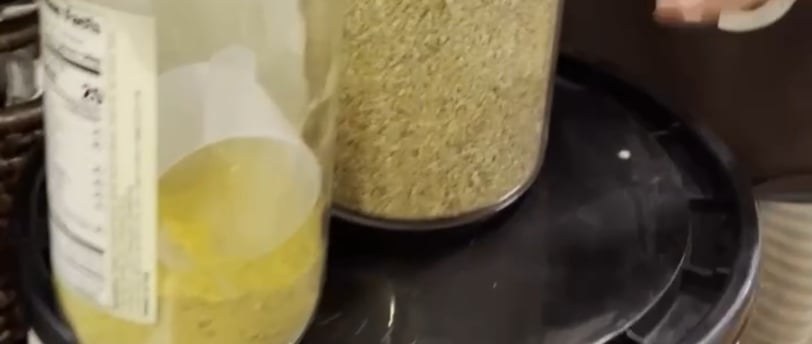Don’t hurt your back when using your bulk food: how to choose and use refill containers
Select refill containers based on where you need to use it, what the contents of the container are, and more
TOOLS AND TECH


Check out this 52 second video I made on bulk food containers and see the tips below:
https://youtube.com/shorts/zoHUAOm_xjI (also, check out the spontaneous good body mechanics of a one year lifting a large (for him) container ;D
Refill smaller containers
Don't shuffle around 5 gallon buckets (or 50lb bags or 55 gallon drums) on a daily basis by using smaller containers. Refill them from your buckets or other larger food storage bags and bins (using good body mechanics!).
1. Choose a container that fits your shelf
Where will you store your smaller container? It should fit on your pantry shelf, counter (think about not just the container height but can you take off the lid and scoop something out under the shelf or cabinet or will you need to move it, and is that okay for you), or wherever else you're storing it. Think of this as the largest container you CAN. have (read on for the smallest it should be).
2. Choose a container that fits the contents
I have a 5lb container for flour and a 8oz jar for salt. They are small enough to fit my space but large enough I don't have to refill them too regularly. If my flour container could only hold 2lbs then I'd have to refill it every time I made my sourdough bread recipe (that makes two loafs). My salt container could be smaller, as it still takes me a while to go through that much salt, but I like the width of the opening and I can fit my measuring spoon in there (more on that below). Plus that's the smallest clean container I had on hand (being practical can be a reason unto itself!).
3. Choose a container that fits your measuring tool
Store your measuring tool in your container. I have a 1 cup measuring cup in my flour container and 1/2 teaspoon in my salt container. As long as my hands are clean and I don't touch the measuring tool to anything (either putting it right back in the container after using it or setting it on the inside of the lid, with the outer part of the lid on the counter, while refilling the container) then it stays clean. That means less dishes to wash AND less rummaging around in a drawer. Put what you usually use in the container. If you usually use a couple measurements, you may want to go smaller (if you use a 1/2 tsp and 1 tsp usually then put in the 1/2 teaspoon so you can get exact measurements for both. You may be able to find measuring tools at a second hand store or garage sale to save money and can of course collect these over time as able. You also can put in a spoon if you use that with your measuring cup (such as spooning milled flour into your measuring cup).
Make sure your container has the width you need. If you're storing your measuring tool in the container than you already know this. If not, try it out before putting the contents into the container (you don't want to dirty your narrow mouth quart mason jar with lentils before realizing your cup doesn't fit into the jar). If you are using mason jars you may prefer a wide mouth for anything you're scooping out of and a narrow mouth for anything you're pouring out directly.
4. Place the Containers (and everything) where you use them
I realized when I feed my sourdough starter I was going to multiple places in the kitchen and pantry for supplies (sourdough starter, flour, water pitcher, scale, narrow spatula). Now I have everything within easy reach of one spot. Whenever you can keep your containers close to where you can use them, that means less carrying of the containers (and better efficiency in general).
5. Consider the materials
I have been transitioning from the plastic containers I got from Costco to glass. I use mason jars I previously used for canning as my smaller containers and I bought the Montana 96oz Acacia and Glass Jar for $28.95 each, from Crate and Barrel. I had bought the Cooper containers first from C&B but the lid did not fit right so I returned them. I am choosing glass because I am physically able to lift them (but plastic should be considered if you need a lighter material or are worried about them breaking) and am concerned about plastic leaching into my food (but I've also heard that's more of a concern for liquids than solids). I have metal measuring cups and spoons and glass liquid measuring cups (with a pour spout). I just purchased wooden measuring spoons to try those but haven't received them yet. What do you prefer for the material your containers and measuring tools are made of?
What have you found works well (or hasn't worked) for your refill containers?
